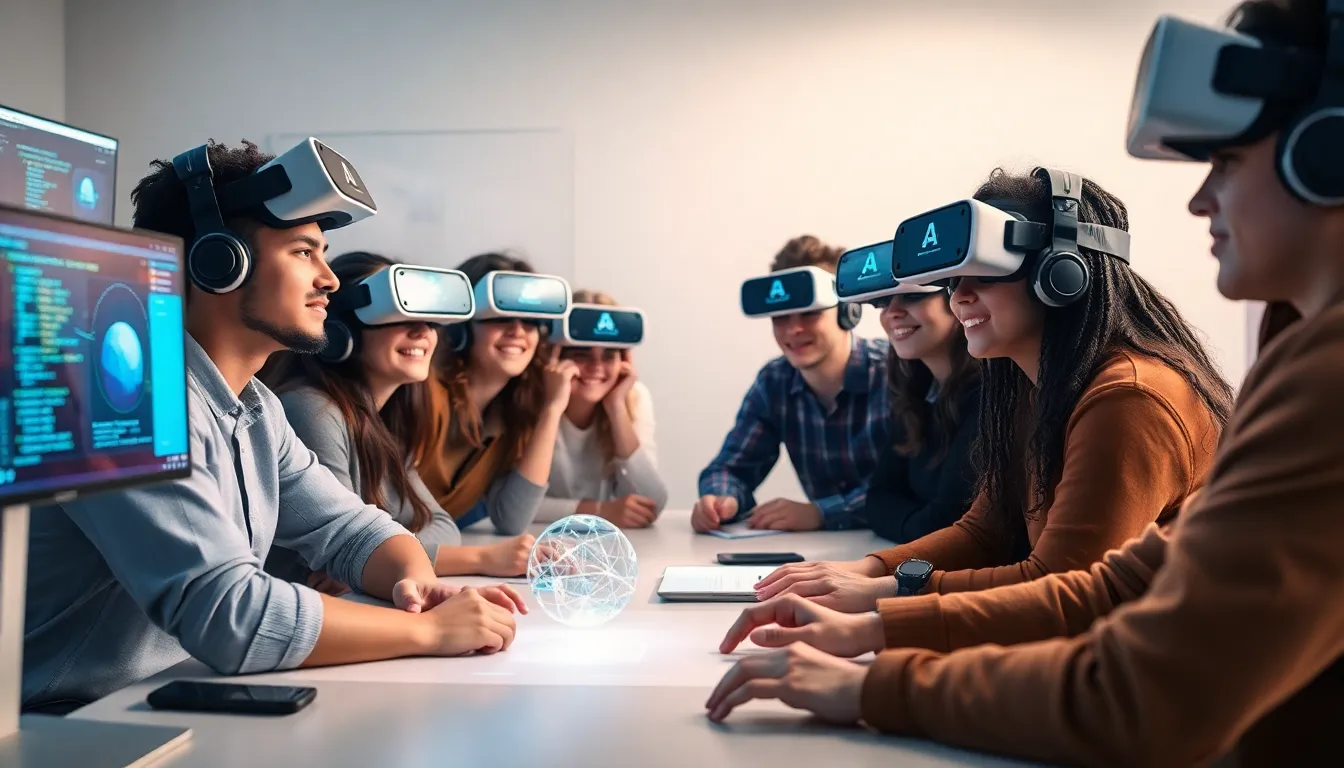Table of Contents
ToggleImagine stepping into a world where your code comes to life right before your eyes. Augmented reality coding isn’t just a tech buzzword; it’s the magic wand developers have been waiting for. By blending the digital and physical realms, AR coding transforms mundane programming tasks into an exhilarating adventure.
Overview of Augmented Reality Coding
Augmented reality coding combines digital information with the physical environment. This innovative approach allows developers to create interactive experiences that engage users on a new level. By using AR coding, developers enhance traditional programming tasks, making them more dynamic and user-friendly.
Several platforms support AR coding, including Unity and ARKit. Unity facilitates immersive 3D experiences, while ARKit allows developers to build applications specifically for Apple devices. Both platforms offer robust tools for creating sophisticated AR applications.
Developers leverage various programming languages in AR coding. C# is commonly used with Unity, providing an accessible way to implement AR features. Swift and Objective-C are prevalent in ARKit projects, allowing seamless integration with iOS functionalities.
User experience design plays a crucial role in augmented reality applications. Designing intuitive interfaces helps users navigate and interact with AR content effectively. Feedback mechanisms enhance usability, ensuring users stay engaged throughout their experience.
Incorporating AR coding into existing workflows provides numerous benefits. Collaboration between teams improves overall project efficiency. Developers can quickly prototype ideas, test concepts, and iterate based on user feedback.
The future of augmented reality coding looks bright. As technology advances, the potential for AR applications continues to grow. Innovations in hardware and software will likely lead to more sophisticated and user-centric experiences.
Benefits of Augmented Reality Coding

Augmented reality coding offers several significant advantages, transforming the way developers create and engage with applications.
Enhanced Learning Experiences
Learning through augmented reality coding becomes an interactive journey. It fosters an immersive environment where complex concepts materialize in three dimensions, making understanding easier. Students encounter real-time feedback, facilitating immediate corrections and adjustments during the coding process. This approach encourages exploration, allowing learners to experiment without the risks associated with traditional methods. Tools like Unity and ARKit specifically cater to educational settings, enabling institutions to integrate AR coding seamlessly into their curricula. As a result, knowledge retention improves substantially, as users actively participate in their learning.
Increased Engagement and Interaction
Engagement levels skyrocket with augmented reality coding. Users interact with virtual elements layered onto the real world, producing a dynamic experience. These interactive features make programming tasks feel more like games, capturing attention and interest. Collaborative opportunities also expand, as teams can visualize projects collectively in real-time. Insights emerge from these interactions, driving innovation and creativity. Integration of AR elements not only enhances user experience but also motivates developers to push boundaries. Utilizing this technology fosters a culture of continuous improvement, encouraging feedback to refine projects effectively.
Tools and Platforms for Augmented Reality Coding
Augmented reality coding relies on a variety of tools and platforms to deliver engaging experiences. These resources streamline the development process and enhance usability.
Popular Software Solutions
Unity stands out as a leading platform for AR coding, offering extensive support and a robust asset store. Developers often choose Vuforia for its easy integration with Unity, providing powerful image recognition capabilities. ARKit is preferred for iOS development due to its seamless integration with Apple devices, while ARCore serves Android developers with advanced tracking features. Other notable tools include Spark AR, which simplifies AR effects for social media, and Lens Studio, designed for creating Snap lenses. Each software solution enables creators to build interactive applications with rich functionalities tailored to various environments.
Coding Languages and Frameworks
C# is frequently used in Unity for developing AR applications, providing a versatile coding experience. Swift and Objective-C are essential for ARKit, allowing developers to leverage iOS’s unique features effectively. Java is a common choice for ARCore projects, as it supports Android’s ecosystem seamlessly. Additionally, JavaScript plays a key role in web-based AR frameworks, such as A-Frame and Three.js, enabling cross-platform experiences. Popular frameworks like React Native also support AR features, making it easier for developers to integrate augmented reality into existing mobile applications. Each language and framework offers distinct advantages tailored to specific AR use cases.
Applications of Augmented Reality Coding
Augmented reality coding finds extensive applications across multiple fields, enhancing user engagement and interactivity.
Education and Training
Education leverages AR coding to create immersive learning environments. Complex subjects transform into three-dimensional visualizations. Real-time feedback engages students more effectively than traditional methods. Platforms like Unity and ARKit facilitate the integration of AR experiences in classrooms, significantly improving knowledge retention. Interactive simulations provide risk-free exploration, making learning processes enjoyable. This technology fosters deeper understanding through engaging interfaces.
Gaming and Entertainment
Gaming and entertainment thrive on the interactive possibilities of AR coding. Developers create engaging experiences that blend digital assets with the real world. Gamers often encounter virtual characters and environments overlaid on their surroundings, enhancing gameplay immersion. Platforms such as Unity support advanced graphics and user-friendly development tools. Popular titles frequently incorporate AR features, driving user engagement and providing novel experiences. The entertainment industry continuously explores innovative ways to captivate audiences through immersive storytelling.
Medical and Healthcare
Medical and healthcare sectors benefit immensely from AR coding capabilities. Surgeons use AR applications for enhanced precision during operations, viewing critical information overlaid on patients. Medical students benefit from AR simulations that offer hands-on practice without risks associated with live procedures. Training programs utilize AR tools to visualize complex anatomical structures, improving retention and understanding. Solutions like ARKit enhance patient education through interactive displays, making medical information more accessible. This technology impressively transforms traditional healthcare practices into highly interactive experiences.
Augmented reality coding is reshaping how developers approach programming by blending the digital and physical realms. This innovative technology not only enriches user experiences but also fosters creativity across various industries. As AR coding continues to evolve, its applications in education, gaming, and healthcare promise to enhance learning and improve user engagement.
With tools like Unity and ARKit at their disposal, developers are well-equipped to create immersive environments that captivate users. The future of AR coding holds immense potential for driving innovation and transforming traditional workflows into dynamic interactive experiences. Embracing this technology could lead to breakthroughs that redefine how people interact with digital content.







